An online project under the direction of the CAPE ANN MUSEUM
inv. 449
Steam demi bark Antelope, 615 tons
Steam Demi Bark Antelope; Steam Demi-Bark "Antelope"
c. 1855 Colored lithograph on paper 11 7/16 x 14 in. (29 x 38 cm) (sheet) 32.5 x 40 cm J.H. Bufford's Lith. 260 Washington St. Boston
Collections:
|
Related Work in the Catalog
Supplementary Images
Additional material
Explore catalog entries by keywords view all keywords »
Historical Materials
Below is historical information related to the Lane work above. To see complete information on a subject on the Historical Materials page, click on the subject name (in bold and underlined).
The steam demi-bark "Antelope" was designed jointly by Samuel Hall and Samuel H. Pook and built in Hall's shipyard at East Boston in 1855. The design concept and construction were closely overseen by Robert Bennet Forbes; the machinery was constructed by Otis Tufts and turned a Griffith propeller. Designed for traveling in pirate-infested Far Eastern waters, the vessel was heavily armed, even fitted out with a pump able to throw hot water from her boilers to a distance of 100 yards. Even the term "demi-bark" was novel, as the barkentine rig was then a novelty itself. John W. Griffiths, in describing this vessel, proposed the term "brigantern," a cross between "brigantine" and "tern," the latter term for a three-mast schooner.
This vessel was described at length by Griffiths in The U.S. Nautical Magazine and Naval Journal 3 (October 1855), 11–17, including Lane's lithograph.
– Erik Ronnberg
vol. 1, no. 1
January 1941
pp. 51-57
Also filed under: "Massachusetts" (Auxiliary Steam Packet Ship) » // Forbes, Robert Bennet »
In the ninteenth century, the term "bark" was applied to a large sailing vessel having three masts, the first two (fore and main) being square-rigged; the third (mizzen), fore-and-aft rigged. The reduced square-rig made the vessel easier and more economical to handle, using a smaller crew. (1)
Barks had significant presence in mid-nineteenth-century America, as indicated by Lane’s depictions of them. Hardly any are to be found in his scenes of major ports, but some do appear in his Cape Ann scenes (see The Fort and Ten Pound Island, Gloucester (Harbor Scene), 1848 (inv. 58), View of Gloucester, 1859 (inv. 91), Gloucester Harbor, 1850s (inv. 391), and Bark "Eastern Star" of Boston, 1853 (inv. 571)), also in views of other small ports and of coastal shipping (see Clipper Ship "Southern Cross" in Boston Harbor, 1851 (inv. 253), Merchantmen Off Boston Harbor, 1853 (inv. 267), Approaching Storm, Owl's Head, 1860 (inv. 399), and Bark "Mary" (inv. 629)).
Brigs, and to a lesser extent ships, were the vessels of choice for Gloucester’s foreign trade in the first half of the nineteenth century. They brought cargos from the West Indies, South America, and Europe, anchoring in the deeper parts of the Inner Harbor while lighters off-loaded the goods and landed them at the wharves in Harbor Cove, by then too shallow for the newer, larger merchant vessels coming into use. (2) By mid-century, barks were gradually replacing brigs and ships, while the trade with Surinam was removed to Boston in 1860. (3)
Some bulk cargos still had to be landed in Gloucester, salt for curing fish being the most important. “Salt barks” brought Tortugas salt from the West Indies, and in the 1870s, Italian salt barks began bringing Trapani salt from Sicily. The importation of salt by sailing ships ended with the outbreak of World War I. (4)
The term barkentine, like the bark, pre-dates the nineteenth century, but in the mid- to late 1800s referred to a large vessel of three masts (or more), with only the fore mast square-rigged, the others being fore-and-aft-rigged. In Lane’s time, the term was little known in the United States, while many other names were coined for the rig. One of these early terms was demi-bark, probably from the French demi-barque, which was applied to a very different kind of vessel. (5) Lane’s depictions of these rigs include a lithograph of the steam demi-bark "Antelope" View of Newburyport, (From Salisbury), 1845 (inv. 499) and at least three depictions of Cunard steamships The "Britannia" Entering Boston Harbor, 1848 (inv. 49), Cunard Steamship Entering Boston Harbor (inv. 197), and Cunard Liner "Britannia", 1842 (inv. 259). (6) None of these subjects typify the barkentine rig as applied to sails-only rigs as they developed in the years after Lane’s death.
– Erik Ronnberg (May, 2015)
References:
1. R[ichard] H[enry] Dana, Jr., The Seaman's Friend (Boston; Thomas Groom & Co., 1841. 13th ed., 1873), 97 and Plate IV with captions; and M.H. Parry, et al., Aak to Zumbra: A Dictionary of the World's Watercraft (Newport News, VA: The Mariners’ Museum, 2000), 43.
2. Alfred Mansfield Brooks, Gloucester Recollected (Gloucester, MA: Peter Smith, 1974), 56, note 10; 67, note 7.
3. James R. Pringle, History of the Town and City of Gloucester (1892. Reprint: Gloucester, MA, 1997), 106–08.
4. Raymond McFarland, A History of the New England Fisheries (Philadelphia: University of Pennsylvania, 1911), 95–96; and Mark Kurlansky, Salt: A World History (New York: Walker & Co., 2002), 419–420.
5. Parry, 44, 167. Dana has neither definition nor illustration of this rig.
6. J[ohn] W. Griffiths, “The Japan and China Propeller Antelope," U.S. Nautical Magazine III (October 1855): 11–17. This article includes an impression of Lane’s lithograph on folded tissue.
Stereograph card
Cape Ann Museum Library & Archive
This view of Gloucester's Inner Harbor shows three square-rigged vessels in the salt trade at anchor. The one at left is a (full-rigged) ship; the other two are barks. By the nature of their cargos, they were known as "salt ships" and "salt barks" respectively. Due to their draft (too deep to unload at wharfside) they were partially unloaded at anchor by "lighters" before being brought to the wharves for final unloading.
– Erik Ronnberg
Also filed under: Historic Photographs » // Salt » // Waterfront, Gloucester »
"Engine-powered vessel" is a collective term used by nautical historians to include all vessel types using engine power of any type for propulsion, whether assisted by sails, oars, or other motive power. In Lane's time, steam reciprocating engines fueled by wood or coal were the only practical source of this power for ships using paddle-wheels or screw propellers to convert heat energy into motion.
For most of the nineteenth century, steamships had sails for auxiliary power; indeed the earliest examples relied principally on sails, using engine power in calm weather to shorten the voyage time or keep to a schedule. As engines became more efficient, powerful, and reliable, sail plans were reduced, to be used only to steady a vessel's motion in a seaway (for the sake of seasick passengers), or to maintain headway if the engine broke down. Only harbor craft, ferry boats, and coastwise passenger steamers relied solely on engine power.
Among Lane's depictions of steamships, the auxiliary steam packet Auxiliary Steam Packet Ship Massachusetts (inv. 442) is a good example of primary reliance on sails, while the steam demi-bark The "Britannia" Entering Boston Harbor, 1848 (inv. 49) and the Cunard Liner "Britannia", 1842 (inv. 259) have relegated sails to secondary (or simply emergency) motive power.
– Erik Ronnberg
Castine Historical Society Collections (2015.03)
Also filed under: Historic Photographs » // Steamers »
Published by James French, Boston
Volume 1848-49
Boston Public Library
Call number 39999059856813
See p. 30 of directory.
Also filed under: "Britannia" (Cunard Steamship) » // "Caledonia" (Cunard Steamship) » // Trade Routes and Statistics »
Cartoon
9 1/4 x 13 3/4 in (23.495 x 34.925 cm)
Peabody Essex Museum, Salem, Mass.
Jonny and a Yankee:
Jonny: "Ho my Hi! 'ow she goes!! it his'nt fair I ham sure t'aint!!! She must 'av an engine hunder the keel..."
Yankee: "Where are your yachts now, Jonny? s-a-y- Do you think your wash tubs can come up to a real Yankee Clipper? Sorry for you, Jonny, but it can't be helped... A Yankee Ship a Yankee Crew, you know Jonny."
Also filed under: "America" (Schooner Yacht) »
Lithograph
Library of Congress Catalog Number 2002706878
Design of side wheel steamer showing wheel mechanism, side view and cross-section in ten figures. This design proved a failure in the few vessels that employed it. The paddle wheel enclosures filled with water, causing resistance which greatly impaired efficiency and increased fuel consumption.
– Erik Ronnberg
Oil on canvas
Maine Maritime Museum
Also filed under: Castine »
Steamer schedules for 1855, including the schedule for the steamer, "T. F. Secor" which served Castine, see pp. 234–35.
Also filed under: "T. F. Secor" (Steamboat) » // Castine » // Publications » // Steamers »
Vessel ornamentation assumed two forms: carvings and color schemes. Carvings, or "ship carvings," as they are called by maritime scholars, are usually crafted in wood and painted or gilt. Many vessels were too small or their owners too frugal to permit carved embellishments, in which cases the enhancement of the vessel's color scheme was a practical alternative. This can be seen in many of the coastal vessels along the new England coast. Pinkies and Chebacco boats had handsome color schemes using only black and green with white sheer lines and limited use of red and yellow. Other combinations of inexpensive pigments were used to improve the simple looks of sloops and schooners in the packet trade, while small pleasure craft and pilot schooners enhanced their appearance in similar ways. Clipper ship owners, finding their vessels' appearance impressive without adding color, settled for unrelieved black hulls. Naval vessels as well preserved their formidable looks with black, relieved only with a white belt in way of the gunports.
The more elaborate ship carvings can be classified in the following categories:
Billetheads: mounted on the bow, at the end of a simple gammon knee, or on the forward end of an elaborate stem-head, they can be scrolls of less or greater intricacy, or sometimes the heads of animals, eagles being the most common. Examples of a sea serpent's head, a pointing hand, and other animal heads have been found. (See Brig "Cadet" in Gloucester Harbor, late 1840s (inv. 13); Brig "Antelope" in Boston Harbor, 1863 (inv. 43); and Brig Off the Maine Coast, 1851 (inv. 241))
Figureheads: mounted on bows of larger vessels, often with elaborate stem joinerwork (trailboards and headboards with associated knees and rails). Usually these were full-length figures representing the ship's owner, a famous citizen, a mythological person or animal, or an eagle. (See Portrait of the "National Eagle", 1853 (inv. 35) (eagle); New York Harbor, c.1855 (inv. 46); The "Britannia" Entering Boston Harbor, 1848 (inv. 49) (female figures); The Ships "Winged Arrow" and "Southern Cross" in Boston Harbor, 1853 (inv. 54) (dragon and eagle); "Starlight" in Harbor, c.1855 (inv. 249) (dragon); and Steam demi bark Antelope, 615 tons, c.1855 (inv. 375) (antelope))
Trailboards: carved vines or scrollwork abaft the figurehead which trail aft along the stem head in a graceful descending arc, terminating at the hawse pipes. They are usually gilt and frequently ornamented with carved rosettes and other devices. (See Brig "Cadet" in Gloucester Harbor, late 1840s (inv. 13); Portrait of the "National Eagle", 1853 (inv. 35); Brig "Antelope" in Boston Harbor, 1863 (inv. 43); New York Harbor, c.1855 (inv. 46); and The Ships "Winged Arrow" and "Southern Cross" in Boston Harbor, 1853 (inv. 54))
Headboards: boards mounted to headrails connecting the figurehead to the ship's mainrail at the catheads. While seldom given any decorative carvings, the vessel's nameboards were often mounted to them. (See Brig "Cadet" in Gloucester Harbor, late 1840s (inv. 13); Portrait of the "National Eagle", 1853 (inv. 35); Brig "Antelope" in Boston Harbor, 1863 (inv. 43); The Ships "Winged Arrow" and "Southern Cross" in Boston Harbor, 1853 (inv. 54); Clipper Ship "Southern Cross" in Boston Harbor, 1851 (inv. 253); and Mary Ann, 1846 (inv. 309))
Catheads: Carved lion heads mounted on the outboard ends of the cathead knees. This term is so archaic that the knees and carvings are treated as one and the same, as in their use, i.e. "catting the anchor" (securing the anchor ring to the cathead). (See Brig "Antelope" in Boston Harbor, 1863 (inv. 43); and An American Frigate Hove-to Off the New England Coast (inv. 535))
Quarterboards: Name boards mounted to the vessel's side near the stern, they usually had ornamental edge moldings and sometimes stars or simple scrollwork at each end of the name. (See Portrait of the "National Eagle", 1853 (inv. 35); Mary Ann, 1846 (inv. 309); and Spitfire Entering Boston Harbor (inv. 536))
Transom arches: arch-form panels fitted to the transom, often over gallery lights (windows) or other carvings. They usually have edge moldings, decorative scrollwork, and sometimes a bust or other carved figure at the center.
Other transom carvings: carved eagles, busts, scrollwork and coats of arms can occupy the space between the transom arch and the sternboard. If galleries are present, carved scrollwork may be fitted between the frames of the gallery lights. (See Boston Harbor, c.1850 (inv. 48); The Topsail Schooner "Kamehameha III" in Boston Harbor, 1846 (inv. 301) (eagle); Baltimore Harbor, 1850 (inv. 400) (eagle); and Rough Sea, Schooners, c.1856 (not published) (eagle and flags))
Sternboard: often the bottom plank of the transom on which the vessel's name is carved or painted, seldom with decoration (stars or scrollwork). There is usually simple protective molding above and below the lettering.
Sideboards, or gangway boards: boards on either side of an entry way at main rail level on a large ship, usually between the main and mizen masts. They are carved and painted or (if of fine hardwood) varnished. Most commonly seen on larger vaval vessels, packet ships, and clipper ships.
– Erik Ronnberg
References:
1. Brewington, M. V., Shipcarvers of North America, (Barre, MA: Barre Publishing Co., 1962).
2. The American Neptune, Pictorial Supplement XIX, "The Art of the Shipcarver" (Salem, MA: The Peabody Museum, 1977).
3. Ship Figureheads (Boston: State Street Trust Co., n.d.).
4. Edouard A. Stackpole, Figureheads & Carvings at Mystic Seaport (Mystic, CT: The Marine Historical Association, Inc., 1964).
Carved wood with paint and gilt
12 x 22 x 8 in.
Cape Ann Museum. Gift of George W. Woodbury, 1936 (747)
This sea serpent billet head came from the schooner "Diadem" which was built in Essex, Massachusetts, in 1855 and owned by D. Elwell Woodbury and John H. Welsh of Gloucester.
Sea serpents were reportedly sighted here on Cape Ann from colonial times through the mid-nineteenth century. In 1817, more than 50 people, many of them prominent members of the community, reported seeing a serpent in the waters of Gloucester Harbor just off Pavilion Beach. So credible were the reports that the Linnaean Society of New England collected depositions from witnesses and published their findings in a small pamphlet entitled Report of a Committee of the Linnaean Society of New England relative to a Large Marine Animal Supposed to be A Serpent, seen Near Cape Ann, Massachusetts, in August 1817.
Also filed under: Objects » // Pavilion (Publick) Beach »
Robert Bennet Forbes (1804–89) of Boston was a key figure in his family's business in the China trade. While his brothers and cousins took positions as land-based merchants stationed either in Boston or Canton, Robert Bennet Forbes chose life at sea. He went on many trips to China, starting in 1817 as a cabin boy—thirteen years old—and eventually as a ship captain.
Forbes became a partner in the firm in 1832, known by then as Russell & Co., Canton, and went for a two-year trip to China in 1838–40 as a merchant. He was a proponent of steam power, which helped ships on the long voyage to China and Japan, and gave them the speed to evade the pirates who were ever present in the opium trade. His firm built about 70 ships, of which he was owner or part owner of several.
Robert Bennet Forbes also helped to introduce yachting as a sport, and participated in some of the first yacht races. His book Personal Reminiscences, published in 1892, lists many of these exploits, as well as all of the vessels he owned and built.
Forbes was known for his adventurous spirit. In 1846, when news of the Irish famine reached Boston, he convinced the U.S.Navy to lend him the "USS Jamestown" to take food to famine sufferers in 1847. He was the first civilian given the honor of commanding a naval vessel, and he crossed the Atlantic in a record seventeen days. Forbes wrote a book about his trans-Atlantic voyage for which he commissioned Lane to make the frontispiece illustration.
The "Jamestown" commission was one of several works Lane made for Forbes. Forbes was not only adventurous but innovative, and he commissioned Lane to make works after two of his newly designed steam vessels: the "Massachusetts," a packet ship that used steam power to supplement wind power, and the "Antelope," that relied primarily on steam power.
The Forbes family lived in Milton, Massachusetts, and also had a home in Beverly, Massachusetts. In 1856 Forbes bought land in West Manchester and built a summer home there which he christened "Masconomo" after the sagamore, chief of the Agawam.
In 1834 Captain Forbes married Rose Greene Smith. She died September 18, 1885, having borne her husband three children: Robert Bennet Forbes (1837–June 30, 1891); Edith Forbes, who married Charles Eliot Perkins; and James Murray Forbes (b. July 17, 1845). He died on November 23, 1889 in Milton.
As reproduced in Yankee Sailing Ship Cards by Allan Forbes and Ralph M. Eastman (Boston: State Street Trust Company, 1948).
Also filed under: "Eastern Star" (Bark) » // Signal Systems (Flags & Maritime Codes) »
Phillips Library, Peabody Essex Museum
1011.2 F695
Also filed under: "Massachusetts" (Auxiliary Steam Packet Ship) »
vol. 1, no. 1
January 1941
pp. 51-57
Also filed under: "Antelope" (Steam Demi-Bark) » // "Massachusetts" (Auxiliary Steam Packet Ship) »
Typed transcription of photograph caption
Manchester Historical Museum, Manchester, Mass.
Also filed under: Manchester, Mass. »
map
Manchester Historical Museum
Also filed under: Manchester, Mass. »
c. 1857
Manchester Historical Museum
In 1856 Robert Bennet Forbes bought nineteen acres of land for $2,800 from Israel F. Tappan in the section of the West Manchester shore known in those days as Newport. There he built Masconomo, named for the sagamore of the Agawam. In her unpublished letters to her son Robert, his wife Rose Greene Forbes wrote:
"...I think Father will put up a good sized cheap summer house, rough pillars, pine furniture etc., and very likely we shall all be there for two months next summer. He means to show people how rational people ought to live at the seaside. What nice times we shall have..."
The house was sold to Benjamin G. Boardman in 1865.
Also filed under: Manchester, Mass. »
Book "Family Photographs" 1:45
Privately Printed: The Riverside Press
Collection of the Forbes House Museum.
Also filed under: Forbes, John Murray » // Manchester, Mass. »
Book
University Press, John Wilson and Sons, Cambridge, Massachusetts
Second edition, 1882, contains "Rambling Recollections Connected with China." Google book version.
Also filed under: "Massachusetts" (Auxiliary Steam Packet Ship) »
Also filed under: Forbes, John Murray »
Robert Bennet Forbes scrapbook
vol. 1, p. 4
Phillips Library, Peabody Essex Museum (SCR 4)
"SPLENDID NAVAL VICTORY. We have received intelligence by the arrival of the Caledonia of one of the most splendid naval victories ever achieved under the American flag..." This article is a humorous metaphor, comparing Forbes' mission to bring food to the starving Irish to a naval assault on the city of Cork.
Also filed under: "Caledonia" (Cunard Steamship) » // "Jamestown" (U.S. Sloop of War) » // Newspaper / Journal Articles »
Perhaps painted in Canton
Collection of the Forbes House Museum
Given to the Forbes House Museum by H.A. Crosby Forbes, Ph.D., Robert P. Forbes, Ph.D., and Douglas B. Forbes in 2012
The painting was commissioned by Robert Bennet Forbes to commemorate the death of his brother, Thomas Tunno Forbes, in 1829 on "The Haide" during a storm off the coast of Macao.
Collection of the Forbes House Museum, Milton, Mass.
Scene depicts the "Jamestown" being towed out of Charlestown Navy Yard. Plaque reads: "To Captain R. Bennett [sic] Forbes / From his English friends. / The "Jamestown" American Sloop of War as she left Boston under his command / bound to CORK with DONATIONS of FOOD / freight free for the Irish. / 1847."
Also filed under: "Jamestown" (U.S. Sloop of War) »
Boston
Eastburn's Press
Link to Google Books.
Also filed under: "Jamestown" (U.S. Sloop of War) » // Lane & Scott's, Lith. – Boston » // Professional »
16 1/2 x 20 1/2 in., on sheet 18 1/8 x 22 1/2 in.
Courtesy American Antiquarian Society, Worcester, Mass.
One of these lithographs was given to R. B. Forbes at an event held on the 19th of April at the Cork Temperance Institute.
"U.S. Sloop of war, Jamestown: Capt. R. B. Forbes. This print, commemorative of the splendid generosity of the American government in dismantling a ship of war for a mission of peace and charity, & of the noble-hearted citizens who humanely & benevolently responded to the call of Irish distress, is respectfully dedicated to the President, House of Representatives, Congress and people of the United States of America, by their obedt. servants, George M. W. Atkinson, William Scraggs, Cove of Cork 13th April, 1847"
Also filed under: "Jamestown" (U.S. Sloop of War) »
Collection of the Forbes House Museum, Milton, Massachusetts
Gift to R. B. Forbes from the U.S. Navy to commemorate voyage of the "Jamestown."
Also filed under: "Jamestown" (U.S. Sloop of War) »
John Henry Bufford (1810–70) was a prominent Boston lithographer working from 1829–70. Bufford began his lithographic career as an apprentice at Pendleton's Lithography in 1829–34. By the end of his time at Pendleton's he was regarded as Pendleton's best draftsman. In 1835, Bufford moved to New York and established his first lithographic firm, it was a failure. After marrying Anne Melora Thayer in 1836, Bufford returned to Boston because of family ties and professional opportunity in 1840. He spent the rest of his life running his own firm, J. H. Bufford, and then a joint venture with his sons under the title J. H. Bufford & Sons. His firms sold prints, photographs, passe-partouts, photo albums, picture frames, and maps. For most of the 1850s and 1860s his shop was located on Washington Street.
This information has been summarized from Boston Lithography 1825–1880 by Sally Pierce and Catharina Slautterback.
Parker & Ditson
Courtesy American Antiquarian Society, Worcester, Mass.
Dedicated to the Tiger Boat Club.
Also filed under: Parker & Ditson, Pub. – Boston » // Sheet Music by other artists » // Thayer's, Lith. – Boston » // Tiger Boat Club » // Yacht & Small Pleasure Craft »
Comp. Marshall S. Pike, Esq.
Also filed under: Sheet Music by other artists »

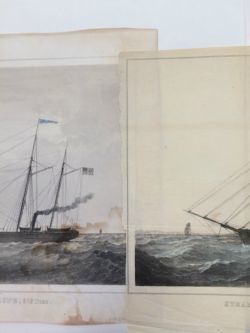
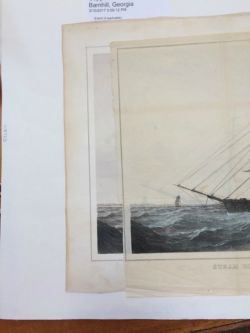
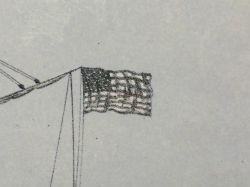
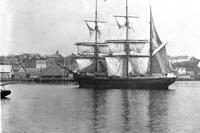

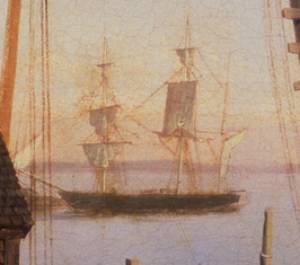


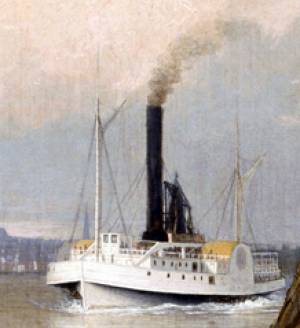

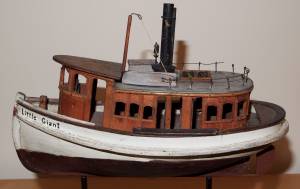

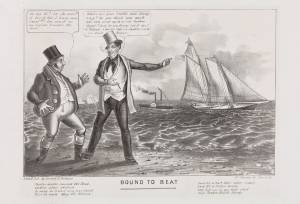

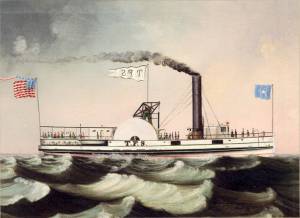
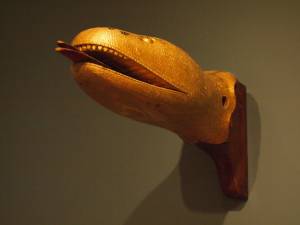




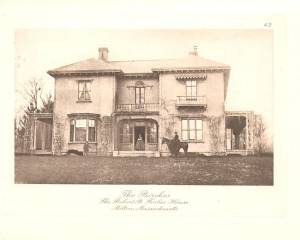
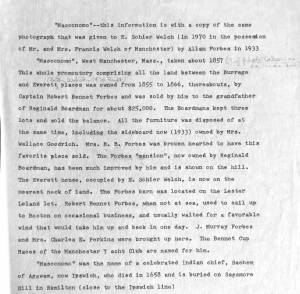
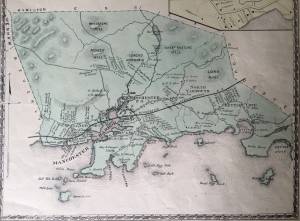
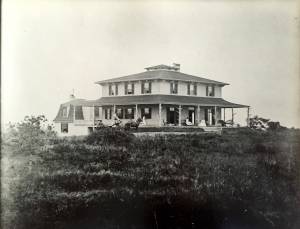
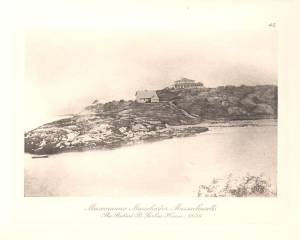
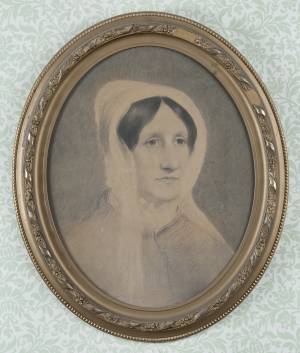


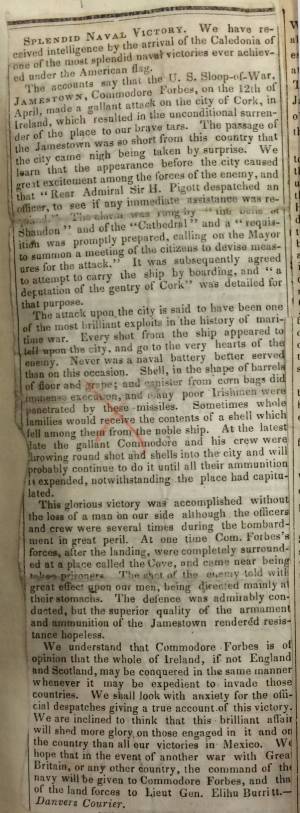
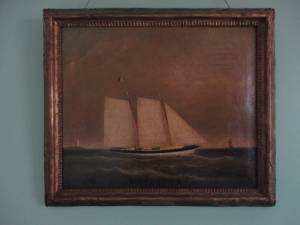
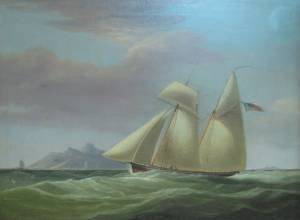

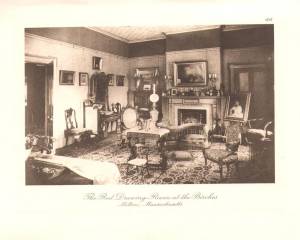




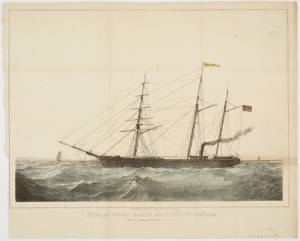
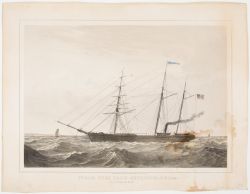
Commentary
In 1855 the Nautical Magazine published an article on R.B. Forbes's steam demi-bark, "Antelope." The article included this lithograph of the vessel made after a painting by Lane. J. P. Newell is signed on the stone in the lower right corner, indicating that he was the artist who lithographed Lane's design. The lithograph for the magazine was printed on tissue-weight paper, and hand-colored. (for example, Steam demi bark Antelope, 615 tons, c.1855 (inv. 375)) A stand-alone version (Steam demi bark Antelope, 615 tons, c.1855 (inv. 740)) was printed on a heavier paper, hand-colored and printed with a tint stone outlining the sky. There is also a third version which has an inscription indicating the original place of publication in the Nautical Magazine. Steam Demi Bark Antelope, c.1855 (inv. 413) The painting from which this lithograph was made is likely the grisaille painting The "Antelope", 1855 (inv. 678).
[+] See More